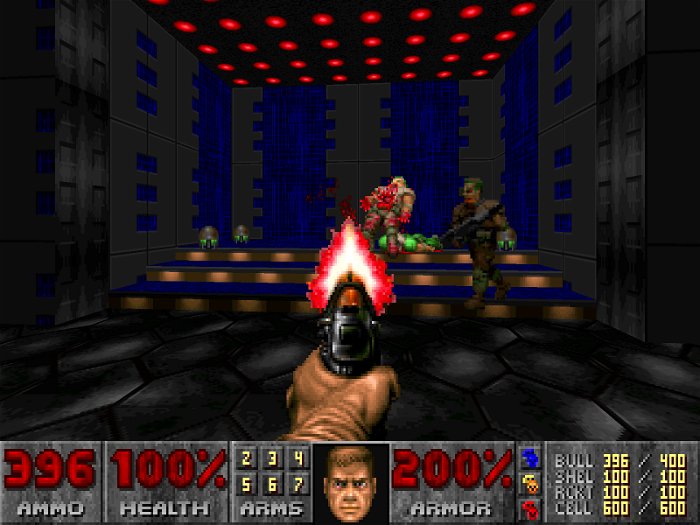
The original DOOM was released in 1993. More than 20 years later, it’s hard to think of what videogames were like before it arrived. The impact that id Software’s hallmark title had on first-person shooters—and videogames as a whole—is still being felt today. But, considering how quickly developers find ways to iterate upon older design principles, it’s surprising to find that DOOM is still such a great experience even today.
I played a good amount of DOOM in the past. Like most kids who grew up in the 90s, it was kind of a hard game to avoid. Though our parents probably wouldn’t have been thrilled if they had taken a closer look at what was flashing on the monitors we glued ourselves to, a number of visits to friends and cousins were devoted almost entirely to exploring the demon-infested hallways of the shooter. To a kid, DOOM was entrancing—all cheesy metal riffs, big guns, and vicious monsters. As an adult, looking at what lies beyond these elements, it’s the game’s design that impresses most.
Shooters have changed an awful lot in the past couple of decades, but not to the point that anything about DOOM seriously dates itself. Though there’s no regenerating health system, action-framing story, or even ability to look up and down, the foundation of the game is timeless. The guns have all been designed with an incredible attention to detail, making every weapon a joy to use in its own right. The monsters all look and fight differently enough from one another that encountering just about combination of them promises an interesting combat scenario. And the feel of moving through the environment, picking up keycards and searching out hidden rooms, is enjoyable on a basic, moment-to-moment level. In other words, DOOM holds up extraordinary well.
I wasn’t expecting to enjoy my return to the game as much as I did. It was mainly curiousity that got me to boot it up again after so long. I wanted to take another look at one of the most influential titles ever released—to try to remove the film of nostalgia and see whether or not it was still fun and not just an important artifact. In a few cases, when I’ve tried to do the same thing, the results haven’t been particularly flattering. Videogames, more than most media, benefit from iteration. Better controllers are built by reconsidering what did and didn’t work in the past; gameplay systems like progress saving checkpoints and level design are often improved by factoring in player feedback from past releases.

All this being said, in DOOM’s case, I still found myself compelled by an experience that, at first blush, seems pretty primitive. Rather than miss the iron sight zoom and clip reloading of modern shooters, I appreciated the immediacy of the game’s approach to gunplay. In the absence of plot-advancing cinematics and character voiceovers, I enjoyed the straightforwardness of simply being dropped into a setting and getting right into exploring the levels. There’s a real value to simplicity in game design. DOOM is a shining testament to this. There’s no waste evident in a play-through of its various episodes, id Software seemingly knowing exactly when to apply its efforts toward details—the gun, enemy, and level design—and when to allow the work to speak for itself, without the distraction of extraneous features.
It can be difficult to remember a time when a game like this didn’t come off as incomplete to audiences. Now, we expect most every mainstream release to come packed with extra gameplay modes and a sprawling campaign, full of well choreographed action setpieces. As much as I appreciate these things—especially well-told stories featuring interesting characters— DOOM shows that they’re not always necessary in titles where the developers aren’t especially interested in providing them.
I would never advocate for a medium where every shooter resembled DOOM, but there is value to be found in assessing what, exactly, it is about the game that still resonates after so many years. Not every classic game is as easy to appreciate, and understanding why DOOM’s design feels so timeless may be a good way to identify what entices long after the elements we find impressive now—showy graphics and superfluous features—become dated.




